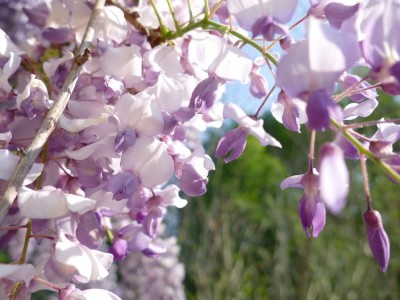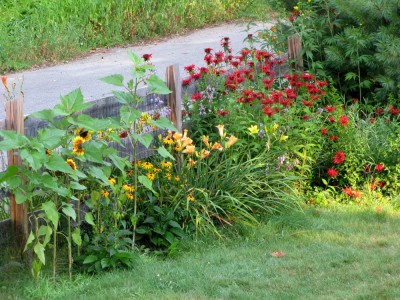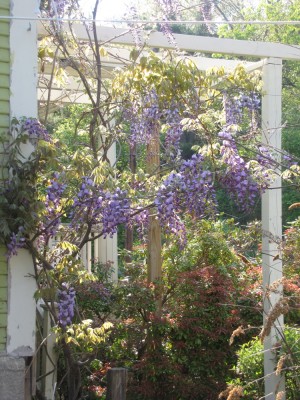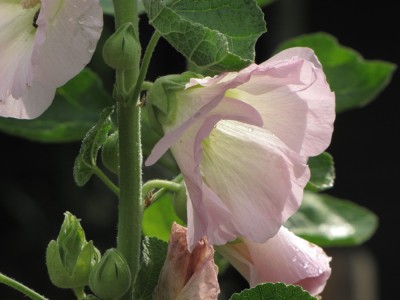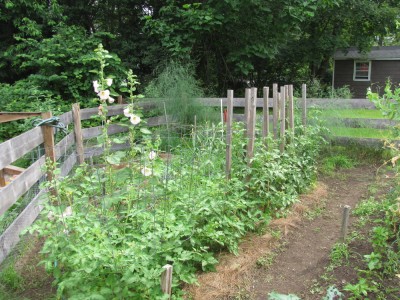posts tagged with 'flowers'
mean deer
I love lilies, and they provide most of the color for the front of our house in July. Or at least they're supposed to. For the past two years deer have stopped by for a visit just before each variety is about to bloom and neatly nibbled off all of the buds. So no color this year. And I want to divide the lilies, but I can't even remember which variety is which if I never seem them bloom! Argh...
in which animals continue to target my gardens
I love lilies, but today all of the beautiful blooms I noticed in people's yards all over town made me feel sad. Why? Because this morning I discovered that, overnight, a deer had eaten off all the buds from the two lily plants in the position of honor in front of the house. We have others—the ones in the backyard along the fence are blooming beautifully—but nobody but us gets to see them! I want to make our house beautiful for passers-by! Seeing everyone else's beauty today—it's a great year for lilies, absent deer predation—made me wonder why the critters are targeting my yard in particular. How does everyone else grow anything?! What am I doing wrong? At least the rabbits took a break from nibbling the petunias for a day or two, so there's a little color out front... Man, who knew gardening was such a stressful hobby!
wisteria week
Most of the year the wisteria on the side of our house is out-of-mind at best, and a downright nuisance at worst: like when it wormed its way through the boys' bedroom window last summer and broke their fan. But for a week or so every May we remember why we have it, because when it blooms it's just about the best thing ever. The look is amazing enough: it's grown considerably since the last time I wrote about it and the trellis is now a solid mass of blooms, with many more trailing off to the sides. But even better is the smell, a sweet perfume that's strong enough to fill our whole house (as long as the dogs haven't recently been playing in the swamp). It doesn't last long, but it's totally worth all the annoyance the rest of the year. We're sure enjoying it now!
the return of the king
We spotted a monarch butterfly in our yard earlier this week: the first of the year. We're always happy to see them, and we do what we can to invite them in and make them feel welcome. There are butterfly-friendly flowers all over the yard, and they're especially concentrated in the side yard, where a discerning lepidopteran can find butterfly bush, tall phlox, beebalm, and, especially for those monarchs, plenty of milkweed. I took a look and I think I spotted a few eggs on the milkweed, so we'll have a hunt for caterpillars in a little while.
While I was sick the other day I read Barbara Kingsolver's Flight Behavior, which I enjoyed even if a few things about it troubled me. Mainly how strongly its main themes were presented as moral lessons: that monarch butterflies are tremendously valuable both for their beauty and for their role as a proxy for wider environmental issues, which I agree with, and that you should leave your spouse if you're not totally in love with them, on which I have more nuanced opinions. Although maybe you shouldn't trust my review of the book since I was pretty loopy with fever when I pushed through the whole thing in basically one sitting (one "lying-in-bedding?"). But yes, monarchs. Yay monarchs!
the seasonality of chrysanthemums
A few days out from the official start of fall, it seems like everyone in our neighborhood—everyone but us—has potted chrysanthemums adorning their front porches. Lot of them! Like they must have been on sale somewhere. Since I'm a contrary old cuss, I have some thoughts.
Now don't get me wrong, mums are lovely. We have a few in our garden, and I love the half-wild ones along the side of the bike path. They're a great sign of early fall; it's so wonderful to see flowers starting to bloom just as most of the others are fading away. The coppery and deep red ones in particular are great fall colors too. But!
Never mind how sad I find it when people buy perennials in pots—daffodils or tulips or easter lillies or mums—and then toss them when their "season" is over. That's their prerogative, and if I don't like it I can just grab the cast-off plants to put in the ground myself (I have, too!). But when you have these plants, forced and trimmed to within an inch of their lives, signifying fall... it just doesn't make sense! They're all greenhouse-grown; they could just have well been forced for any other time of year. And worse, the same way you get mums you could just as well have, oh, I don't know, petunias! That is to say, there's no horticultural reason for people to be buying mums—they're just doing it because that's what one does in the fall.
It's like the plastic pumpkins that have started to move from basements to front lawns over the past couple weeks. Why are pumpkins a sign of fall? Because they don't ripen until well into the fall, when everything else is dying. So it maybe doesn't make so much sense to put them out in early September when the sweet corn and summer squash and tomatoes are still going strong. There's nothing wrong with early pumpkins—either plastic or genuine—but their connection with the season is artificial and so less meaningful and interesting.
And that's true of so many things. We celebrate the turning seasons, but we're completely insulated from any real affects as they change. Our homes are heated and cooled to the same temperature all year round; our jobs are completely season- and weather-independent; we can eat watermelon and peas and raspberries all year round. So I guess it makes sense that we need to resort to artificial means to bring back some sense of seasonality. For sure, I agree that seasons are great! And to appreciate them even more, I suggest some slightly more intensive gardening: toss those potted mums into a hole and water them a little until it freezes, and they'll come back next year—at just the right time to celebrate the fall!
for the birds
When we moved into this house ten years ago, it was in much better shape than it is today in lots of ways, but it was seriously short of flowers. The landscaping we inherited could boast of no more color than rhododendrons a couple weeks a year. Bit by bit, I'm working to change that.
We appreciate the variety, and I hope the neighbors enjoy it a little bit—in compensation for some of our other landscaping failures—but the biggest winners are the birds. The headliners the last few weeks have been the hummingbirds that feed from the bee balm (those red flowers in the picture above). They're always thrilling to watch, even when I see them every day (they're also completely unphotographable with my skills and equipment, and really tough to point out to the kids). I've also been noticing goldfinches enjoying the seeds of the black-eyed susans, and house sparrows are currently nesting in the wisteria vines. Blackberries aren't flowers, but they're another aspect of our landscaping that attracts birds: specifically some sort of gray jay-like bird with a call that sounds like a cross between an upset baby and an upset cat. Anyone have any idea what it might be?
None of these birds—with the exception of the house sparrows—would have had any place in our yard of ten years ago. It's not a big deal, and I didn't set out to make a bird-friendly environment, but I like having them around. Just like we want to offer hospitality for people I'm delighted to extend it to birds as well.
wisteria
Gardening is all about waiting for the reward, and some things make you wait longer than others. Like asparagus. Or, even more so, wisteria. It took ours ages to get established (slower because I didn't give it anything to climb for years) and, of course, it only blooms for a couple weeks of the year—the rest of the time it tries to get in the windows and tear the siding off the house. But the flowers are nice.
And not only for the visual impact: they smell wonderful too. It's been warm enough to have the fans on most nights lately, and their perfume blowing in through the windows is just the thing to fall asleep to.
And when they're done in a few days there will be something else to enjoy.
unplanned beauty
Among the many plants in our gardens this year we have a pair of beautiful pink hollyhocks. Aside from enjoying them because they're quite pretty on their own terms, I also appreciate their old-fashioned look. The only problem is, they both self-seeded and they're perhaps not in the most convenient locations. The one next to the driveway is fine, but the other one...
It's right on the edge of the bed where I put many of the tomato plants, and the only positive is that it's alongside the determinate varieties—the ones I'm growing in cages and mostly leaving alone, from a pruning point of view. But still, it'll be in the way soon, if it isn't already. I may have to take it out some time soon, but what a shame that would be!
Oh well, at least it isn't as bad as the year I left one to grow out of a crack in the walkway right in the middle of back steps.
